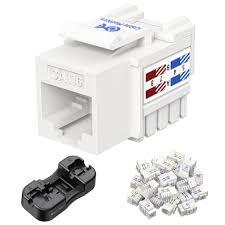Why Keystone Jacks Matter in Structured Cabling Systems

Let’s get one thing straight: if you’re building or maintaining any kind of structured cabling system, keystone jacks are not just an accessory—they’re core infrastructure. You can have the best cables in the world, but without the right connectors at the endpoints, you’re asking for signal degradation, poor network performance, and an all-around unreliable setup.
So, what makes keystone jacks such a big deal? Here’s the breakdown.
What Is a Keystone Jack, Anyway?
A keystone jack is a standardized snap-in connector used in data, voice, and video networks. They usually live inside wall plates, surface-mount boxes, or patch panels. You’ve definitely seen them: those little modular openings where Ethernet cables click into place.
The key here is modularity. "Keystone" refers to the shape—these jacks are designed to fit into a universal rectangular port, making them interchangeable and easy to install or replace.
The Backbone of Structured Cabling
Structured cabling is meant to bring order to network infrastructure. It’s modular, organized, and designed for scalability. Keystone jacks are essential to making this happen.
Here's why:
1. Consistent Performance Across the Board
A high-quality keystone jack ensures a solid connection between cables and devices. It preserves signal integrity—especially in high-speed networks like Cat6, Cat6A, or Cat7.
Poor-quality jacks? Expect crosstalk, interference, and drops in performance. You wouldn’t put budget tires on a race car, right? Same logic applies here.
2. Simplified Installation and Maintenance
Ever tried re-running a cable because the jack failed or didn’t fit your wall plate? Keystone jacks solve that problem. Their universal fit makes installations quick and maintenance painless. Need to swap out a jack? Snap it out, snap in a new one. No need to mess with the cabling behind the wall.
For IT techs and installers, that’s a game changer.
3. Scalability for Future Growth
Let’s say you’re wiring up a small office. Today it’s Cat6, but in two years, maybe you’re upgrading to Cat6A or beyond. With keystone jacks, you don’t need to rebuild your patch panels or wall plates—just replace the jacks.
This modularity gives you a future-proof network layout that adapts without a total overhaul.
4. Clean, Professional Finish
A big part of structured cabling is keeping things clean and organized. Keystone jacks contribute to that by providing a tidy, uniform look—especially in visible areas like meeting rooms or reception areas.
They also help with cable management, which is more important than most people realize. Tangled cables lead to overheating, interference, and a headache when troubleshooting.
Where Keystone Jacks Fit In
Let’s break down where you’ll find keystone jacks doing their thing:
-
Patch Panels: Mounted in server racks, keystone patch panels are where multiple cable runs terminate. You can easily organize ports by function or department.
-
Wall Plates: These go on walls, desks, or floors. Inside conference rooms or offices, keystone wall plates provide network access points that are sleek and user-friendly.
-
Surface-Mount Boxes: Used where wall plates aren’t practical—like concrete walls or temporary setups.
-
Faceplates with Multimedia: Keystone jacks aren’t just for Ethernet. You’ll find versions for HDMI, USB, fiber, and even audio connectors. That’s what makes them so versatile.
Shielded vs. Unshielded Keystone Jacks
Not all keystone jacks are created equal.
-
Shielded Jacks (STP): Best for environments with a lot of electrical noise—think factories, hospitals, or data centers. They protect against EMI (electromagnetic interference) and preserve signal quality.
-
Unshielded Jacks (UTP): Ideal for most office or residential settings. They’re easier to install and more cost-effective, as long as the environment doesn’t pose serious interference risks.
Choosing the right type depends on your specific environment and network demands.
Key Features to Look For
If you’re shopping for keystone jacks, here’s what to pay attention to:
-
Category Rating: Make sure the jack matches your cable type—Cat5e, Cat6, Cat6A, Cat7, etc.
-
Tool-less vs. Punch Down: Tool-less jacks are great for quick installs, while punch-down types offer a more secure, long-lasting connection.
-
Compatibility: Ensure it fits standard keystone wall plates and patch panels. Most do—but don’t assume.
-
Color Coding: Helpful for organizing multiple connections across departments or functions.
Real-World Applications
-
Offices: Easily deploy internet, phone, and printer connections across rooms and cubicles.
-
Data Centers: Organize thousands of ports with precision, speed, and flexibility.
-
Smart Homes: Keystone jacks allow for clean integration of Ethernet, HDMI, or coaxial connections in walls—ideal for home theaters and networked devices.
-
Education & Healthcare: Reliability and speed are critical. Keystone jacks provide consistent performance in demanding environments.
Common Mistakes to Avoid
A few quick tips to sidestep trouble:
-
Don’t mix categories. Plugging a Cat5e cable into a Cat6A jack won’t break things, but it’ll bottleneck your performance.
-
Label everything. You’ll thank yourself during upgrades or troubleshooting.
-
Watch your terminations. Bad crimps or untwisted pairs kill signal performance. If you’re not confident in your skills, go with tool-less jacks.
Final Thoughts
Keystone jacks might seem like a small detail in the grand scheme of network infrastructure—but they’re not. They’re the linchpins that hold your structured cabling system together, enabling consistent performance, easier maintenance, and room for future growth.
Think of them like LEGO bricks for your network: modular, flexible, and absolutely essential. Skip the cheap stuff. Choose the right jack for the job. Your entire network depends on it.
- Art
- Causes
- Crafts
- Dance
- Drinks
- Film
- Fitness
- Food
- Παιχνίδια
- Gardening
- Health
- Κεντρική Σελίδα
- Literature
- Music
- Networking
- άλλο
- Party
- Religion
- Shopping
- Sports
- Theater
- Wellness
